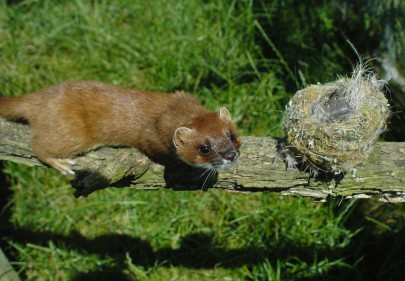
Stoat approaching a bird nest
The international collaboration to sequence the stoat genome was led by Dr Andrew Veale at Manaaki Whenua. “Stoats will be one of the trickiest pests to eradicate across Aotearoa, but the completed genome provides great opportunities to understand their biology, and to create tools to assist conservation,” says Dr Veale.
The assembled stoat genome is over 2.4 billion DNA bases long, with over 20,000 identified protein-coding genes. This new genome is one of the highest-quality vertebrate genomes ever produced, with nearly gapless complete chromosomes assembled and annotated.
“This sets us up for the breakthrough research we will need to realise the Predator Free 2050 goal,” says Professor Dan Tompkins of Predator Free 2050 Limited, which co-funded the research as part of its Science Strategy. “Knowing the genetic code of these devastating predators is an important step towards finding their Achilles heel.”
The project was also co-funded by the New Zealand’s Biological Heritage National Science Challenge and involved collaboration with scientists from the Vertebrate Genome Project, based at the Rockefeller Institute in the US and the Wellcome Sanger Institute in the UK.
The stoat genome is already being used to assist conservation efforts in New Zealand, and there are many other projects on the horizon. Dr Veale is currently mapping the connectivity of stoat populations across the landscape using spatial models, relying on novel genetic markers. “Once we have the precise relatedness of each individual and their location of capture, we can create models showing how the animals disperse across the New Zealand landscape. These models can then be used to optimise trapping networks, enabling traps to be placed to prevent reinvasion into areas cleared of stoats.”
Dr Veale is also developing forensic genetic markers from the genome sequence to identify individual stoats from trace samples, such as scat, saliva and hair. These markers can then be used in a CSI-type setting. For instance, if a conservation programme discovers a dead kiwi with a bite mark, and a dead stoat in a trap, it is now possible to answer the question, “Was this the stoat that killed the kiwi, or is there another one out there?”
Dr Erica Hendrikse, a postdoctoral researcher at Manaaki Whenua working with Dr Veale and Dr Brian Hopkins, is currently using the stoat genome (along with the ship rat and possum genomes) to look for ways to develop species-specific toxins. This work is SSIF-funded.

